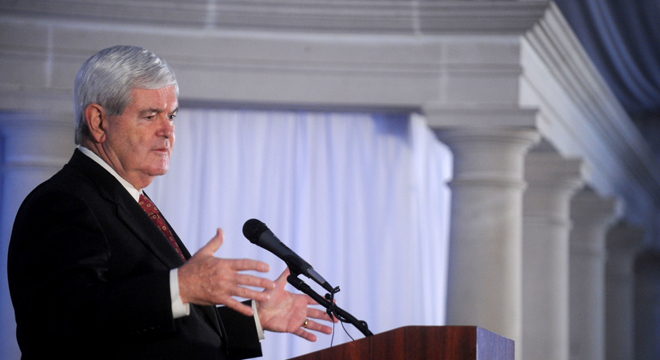On Monday, the Tax Policy Center published an analysis of Newt Gingrich’s plan to overhaul the tax code — the latest in a series of of analyses of GOP presidential candidate tax proposals. And like all the plans that came before it, Gingrich’s constitutes a massive tax cut for the rich. Indeed, no matter how you stack the numbers, Gingrich wants a tax system that permanently holds tax rates on the highest earners lower than tax rates on the middle class.
There are a lot of ways to parse the data. Gingrich proposes creating an alternative tax system that would significantly flatten the code, while keeping the current one in place as an option. So you can run the numbers assuming everybody jumps into the new system, or you can run them assuming that the only people who hop into the new system are people who would benefit financially as a result. And you can compare Gingrich’s plan to current tax policy — including the Bush tax cuts and other temporary tax policy — or you can compare it to current law, which assumes all of these policies will expire in the next year, and go up on just about everyone.
To be as fair as possible, let’s take Gingrich at his word that he would extend the Bush tax cuts for those staying in the current system, and that the only people who would opt into the new system are those who would pay lower taxes as a result.
Here’s what happens to people’s average federal tax burden as a result.
Aside from a quirk that would result in the super poor paying a slightly higher average tax rate than the merely impoverished, Gingrich’s plan takes a broadly progressive approach for most taxpayers. But look what happens just past middle-class territory. Somewhere above $200,000 annual income, the average rates max out, and taxpayers begin paying a smaller percentage of their income than those less fortunate. It’s like codifying the problem President Obama’s “Buffett Rule” was meant to solve.
This is true regardless of your assumptions about the Bush tax cuts and the likelihood that lower and middle-income people would transfer into the new program. Unlike Herman Cain, whose 9-9-9 plan was nearly popular enough among GOP base voters for him to withstand a number of allegations of sexual misconduct, Gingrich is not proposing to raise taxes on middle income. His plan is broadly comparable to Rick Perry’s. Both are designed in essence to create a separate tax code for “the one percent,” under which they’ll get huge tax cuts (for a funny illustration of this, see here). It’s no surprise then that the Gingrich plan, like Perry’s, would starve the federal government of revenues and require either massive, unspecified cuts to essential federal support programs, or else hasten a fiscal crisis.
Per the Tax Policy Center, “The Gingrich plan would reduce federal tax revenues dramatically. TPC estimates that on a static basis, the Gingrich plan would lower federal tax liability by $1.28 trillion in calendar year 2015 compared with current law, roughly a 35 percent cut in total projected revenue. Relative to a current policy baseline, the reduction in liability would be roughly $850 billion in calendar year 2015. If taxpayers were required to file under the flat tax option (that is, they could not opt to remain under current tax law), revenues in 2015 would fall by about $1.25 trillion relative to a current law baseline and by about $830 billion relative to a current policy baseline.”







